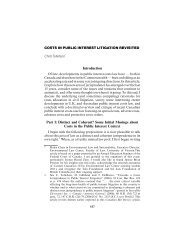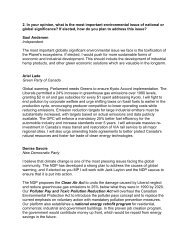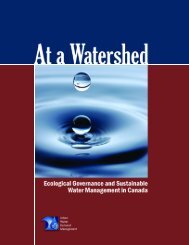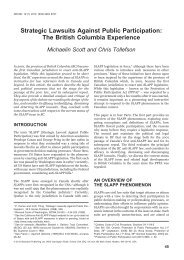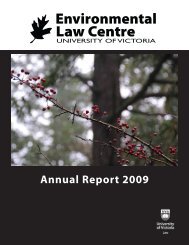Peeling back the Pavement - POLIS Water Sustainability Project
Peeling back the Pavement - POLIS Water Sustainability Project
Peeling back the Pavement - POLIS Water Sustainability Project
Create successful ePaper yourself
Turn your PDF publications into a flip-book with our unique Google optimized e-Paper software.
Blueprint principle 2: let rain do <strong>the</strong> work<br />
implement widespread rainwater harvesting<br />
First Step<br />
Promote Non-Potable <strong>Water</strong> for All Irrigation<br />
Ensure all institutions, city parks, boulevards, recreation areas, swimming<br />
pools, and golf courses are using rainwater for irrigation and<br />
o<strong>the</strong>r non-potable uses, especially outdoor uses.<br />
Overcome Code Restrictions<br />
Building and plumbing codes must be amended to allow for <strong>the</strong><br />
widespread use of rainwater for indoor non-potable uses. Overcoming<br />
barriers and promoting this “off <strong>the</strong> grid” water supply requires all<br />
levels of government to take an active role. National, provincial,<br />
and territorial building and plumbing codes should be updated to<br />
differentiate between greywater, non-potable water, and rainwater.<br />
Building codes should explicitly permit and mandate <strong>the</strong> use of<br />
rainwater harvesting and greywater systems in homes and commercial<br />
buildings for irrigation, clo<strong>the</strong>s washing, toilet flushing, and in heating<br />
and cooling units.<br />
National, provincial, and territorial codes must explicitly expand<br />
permitted end uses. Until recently, it was difficult to get approval to use<br />
non-potable water supplies in dwellings in Canada. However, both <strong>the</strong><br />
National Building Code (NBC) and <strong>the</strong> National Plumbing Code (NPC)<br />
now permit <strong>the</strong> use of non-potable water for some uses, such as toilet<br />
flushing. In its proposed revisions of provincial building and plumbing<br />
codes, Ontario has gone a step fur<strong>the</strong>r by allowing clo<strong>the</strong>s washers to<br />
be connected to rainwater supplies.<br />
next Steps<br />
Develop Provincial/Territorial Guidelines and Policy Support<br />
Mitigate concerns about liability for innovative communities by<br />
developing mechanisms for flexibility or standardized technical<br />
requirements related to green infrastructure and rainwater harvesting;<br />
best management practices regarding end uses, treatment, and<br />
maintenance; and general guidance on how to implement rainwater<br />
harvesting on a widespread scale.<br />
Develop Local Government Support and Guidelines<br />
Adapt provincial and territorial guidelines (or technical requirements)<br />
to local circumstances. Ensure that guidelines are adaptable and able<br />
to change as best practices evolve. Incorporate <strong>the</strong> guidelines into<br />
community and regional planning documents.<br />
Mandate Dual Plumbing for All New Developments<br />
Look to <strong>the</strong> future and ensure all new developments contain purple<br />
pipes, regardless of whe<strong>the</strong>r <strong>the</strong>y are immediately connected to a<br />
non-potable water source.<br />
Overcome Cost Barriers<br />
Introduce incentives for property owners to implement rainwater<br />
harvesting such as rebate programs (including installations) and full<br />
cost conservation-based pricing of municipal water supply. To realize<br />
economies of scale, start with large properties such as institutions and<br />
industry. 41



